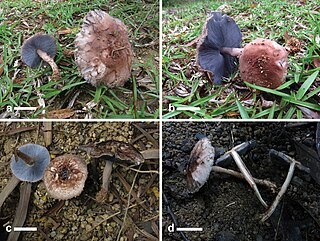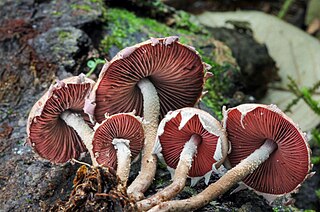Related Research Articles

Lepiota is a genus of gilled mushrooms in the family Agaricaceae. All Lepiota species are ground-dwelling saprotrophs with a preference for rich, calcareous soils. Basidiocarps are agaricoid with whitish spores, typically with scaly caps and a ring on the stipe. Around 400 species of Lepiota are currently recognized worldwide. Many species are poisonous, some lethally so.

The Agaricaceae are a family of basidiomycete fungi and include the genus Agaricus, as well as basidiomycetes previously classified in the families Tulostomataceae, Lepiotaceae, and Lycoperdaceae.

The Hygrophoraceae are a family of fungi in the order Agaricales. Originally conceived as containing white-spored, thick-gilled agarics, including Hygrophorus and Hygrocybe species, DNA evidence has extended the limits of the family, so it now contains not only agarics, but also basidiolichens and corticioid fungi. Species are thus diverse and are variously ectomycorrhizal, lichenized, associated with mosses, or saprotrophic. The family contains 34 genera and over 1000 species. None is of any great economic importance, though fruit bodies of some Hygrocybe and Hygrophorus species are considered edible and may be collected for sale in local markets.

Arachnion is a genus of gasteroid fungi in the family Agaricaceae.
Crucispora is a genus of fungi in the family Agaricaceae. The genus, described by mycologist Egon Horak in 1971, contains two species found in New Zealand and Asia.

Floccularia is a genus of fungi in the order Agaricales. There are four recognized species in the genus, which have a widespread distribution, especially in northern temperate regions. Two former species are now classified as a Cercopemyces and an Amanita. Floccularia was circumscribed by Czech mycologist Zdeněk Pouzar in 1957.

Gastropila is a genus of fungi in the family Agaricaceae. The genus, described in 1973, contains four puffball-like species distributed in the Americas.

Heinemannomyces is a fungal genus in the family Agaricaceae. This is a monotypic genus, containing the single species Heinemannomyces splendidissima, which was defined in 1998 by Roy Watling. It is found in peninsular Malaysia and China.

Melanophyllum is a genus of fungi in the family Agaricaceae. The widespread genus contains four species.

Montagnea is a genus of fungi in the family Agaricaceae. The genus has a widespread distribution in subtropical dry areas, and contains six species. Montagnea was circumscribed by Swedish mycologist Elias Magnus Fries in 1836.

Panaeolopsis is a genus of fungi in the family Agaricaceae. The genus has a widespread distribution and contains four species. Panaeolopsis was circumscribed by Rolf Singer in 1969 with P. sanmartiniana as the type species.
Phlebonema is a fungal genus in the family Agaricaceae. It is a monotypic genus, containing the single species Phlebonema chrysotingens, described by Roger Heim in 1929 from Madagascar. According to the Dictionary of the Fungi, the placement of this little-known genus in the Agaricaceae is uncertain.
Queletia is a genus of fungi in the family Agaricaceae. The genus was circumscribed by Elias Magnus Fries in 1872. Fruit bodies of Queletia species are sequestrate with a thin outer skin (peridium) and a harder inner skin that breaks into small pieces with age. The genus is named after French mycologist Lucien Quélet (1832–1899).
Rugosospora is a genus of fungi in the family Agaricaceae. The genus contains two species: R. ochraceobadia, found in Africa, and R. pseudorubiginosa, found in Colombia and Mexico. These species have fruit bodies (mushrooms) with free gills, a white spore print, and a ring on the stipe. Rugosospora was circumscribed by Belgian mycologist Paul Heinemann in 1973.
Episphaeria is a genus of fungus in the Agaricales. The genus is monotypic, and contains the single rare species Episphaeria fraxinicola, found in Europe. Its familial position is not known with certainty. The tiny fruit bodies of the fungus resemble minute, white cups that grow scattered or in groups on the bark of ash trees.

Campanophyllum is a fungal genus in the family Cyphellaceae. The genus is monotypic, containing the single species Campanophyllum proboscideum, found in Costa Rica. The genus was circumscribed in 2003 to accommodate the species formerly known as Lentinus proboscoides.

Morganella is a genus of puffball fungi in the family Agaricaceae. The genus name honors American botanist Andrew Price Morgan (1836–1907). The widely distributed genus is prevalent in tropical areas. A 2008 estimate placed nine species in Morganella, but several new species have since been described.
Clarkeinda trachodes is a poisonous mushroom in the family Agaricaceae. This agaric species is only distributed in South and Southeast Asia in countries such as Bangladesh, China, India, Indonesia, Malaysia, and Sri Lanka. It has both a partial and universal veil, and dark-colorer spores.
References
- 1 2 "Clarkeinda Kuntze 1891". MycoBank. International Mycological Association. Retrieved 2012-11-04.
- 1 2 Clements FE (1909). The Genera of Fungi (1st ed.). Minneapolis, Minnesota: H.W. Wilson. p. 114.
- ↑ Kirk PM, Cannon PF, Minter DW, Stalpers JA (2008). Dictionary of the Fungi (10th ed.). Wallingford, UK: CAB International. p. 147. ISBN 978-0-85199-826-8.
- ↑ Hosen MI, Ge ZW (2011). "Clarkeinda trachodes (Agaricales, Basidiomycetes), first record from Bangladesh". Mycotaxon. 118: 331–336. doi: 10.5248/118.331 .
- ↑ Yang ZL (1991). "Clarkeinda trachodes, an agaric new to China". Acta Botanica Yunnanica. 13: 279–282.
- ↑ Kuntze O. (1891). Revisio generum plantarum (in Latin). Vol. 2. Leipzig, Germany: A. Felix. p. 848.
- ↑ Rea C. (1922). British Basidiomycetae: A Handbook to the Larger British Fungi. Cambridge, UK: Cambridge at the University Press. p. 97.